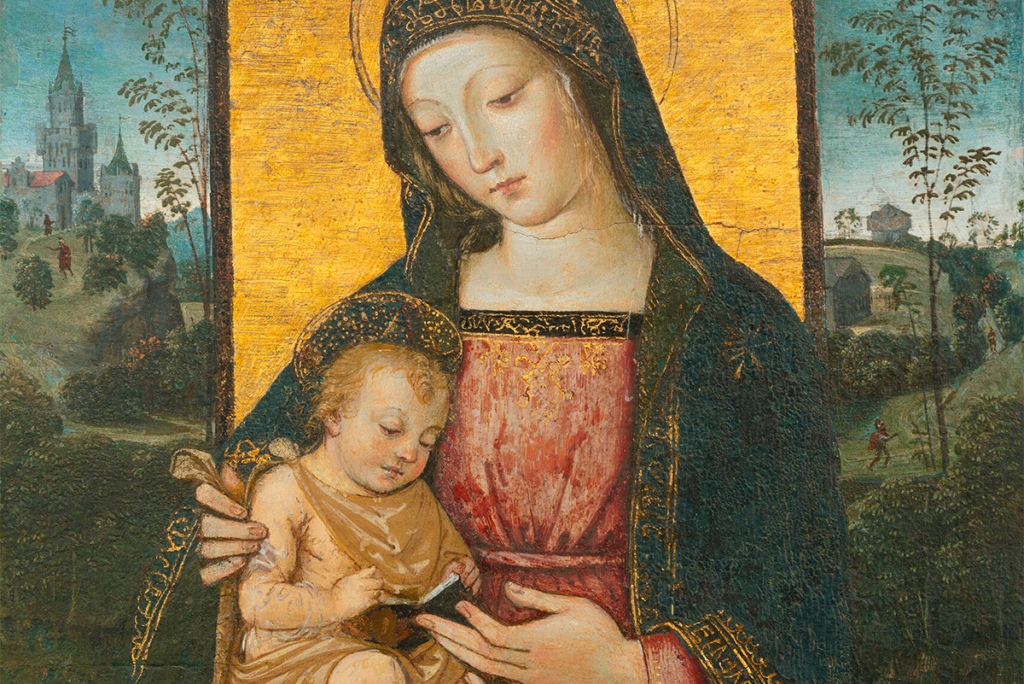Museum Report from the Isabella Stewart Gardner Museum
 I greatly enjoyed my visit to the Isabella Stewart Gardner Museum. My favorite art piece has to be the Virgin and Child by Bernardino Pinturicchio. It is a small painting: about only 12 inches tall and 10 inches wide. Pinturicchio painted this portrait of Mary and Jesus, which is one of many such paintings, around the years 1490 to 1495. Keeping this in mind, now I want to discuss some reasons why this painting caught my attention. Then, I want to describe some of the feelings I had about this painting. Finally, I want to describe this painting and explain some specific elements that caused me to be attracted to this painting.
I greatly enjoyed my visit to the Isabella Stewart Gardner Museum. My favorite art piece has to be the Virgin and Child by Bernardino Pinturicchio. It is a small painting: about only 12 inches tall and 10 inches wide. Pinturicchio painted this portrait of Mary and Jesus, which is one of many such paintings, around the years 1490 to 1495. Keeping this in mind, now I want to discuss some reasons why this painting caught my attention. Then, I want to describe some of the feelings I had about this painting. Finally, I want to describe this painting and explain some specific elements that caused me to be attracted to this painting.
I want to start the life of Pinturicchio with a quote about him from Giorgio Vasari, “[He] had a much greater name than his works deserved.”1 I believe these simple words sum up the life of Pinturicchio. Now here is a brief account of his life I found:
“Bernardino di Betto, known also as Pinturicchio, was born between 1456 and 1460 in Perugia […] [His] early life seems to have been very unhappy and was further complicated in 1475 when his father died of the plague […] It was not, however, until 1481 that his first authored works are documented, following his enrolment in the guild of Artists and Painters in Porta Sant’Angelo, Perugia […] In Siena – where he finally settled, married, had children, and died – he had important commissions for the Cathedral, for the Church of San Francesco, and for Pandolfo Petrucci, the chief citizen of the city […] Pinturicchio’s career skyrocketed in Rome where he was active on paintings such as this one for a local church, and where he was later hired by the reigning pope, Alexander VI […] In 1513 he retired, due to ill health, to the Sienan countryside, where he died on the 11th December.”2
I want to conclude this brief account with words that Giorgio Vasari attributed to him “A painter could only give the greatest relief to his figures when he had it in himself, without owing anything to principles or to others.”3
I saw many fascinating details hidden within this small painting. First, I was struck by how small the picture was. It is not even a square foot. Then, I was deeply moved by the faces of Jesus and Mary. I was also a bit mystified by the gold box behind Mary’s head. Perhaps it is a halo or some sign of holiness. I also liked how Pinturicchio used different colors in this painting, especially gold. Finally, I was curious about the meaning of the castle in the far background and what baby Jesus is reading, if he can read at that age.
My principal feeling about this painting is peace. When I looked at this painting for the first time, I almost went straight to contemplative prayer. I felt a deep peace looking at the loving face of Mary and baby Jesus, who seemed asleep. They appear to be enjoying each other’s presence while radiating deep inner peace. This painting also strengthens my love for baby Jesus and Mary. I see Mary as a tender mother and baby Jesus as a cute baby. I almost want to ask Mary to hold baby Jesus myself. So, I believe that these are the two main feelings this painting portrays for me.
Now that I have explained my feelings about this painting, I want to describe the events unfolding within this painting. I will start from the top of the painting and then work my way down. The sky seems to be overcast. There are no clouds, but the sky is a dark, foreboding blue. Then, in the background, on the left of Mary, is a castle surrounded by trees and a few distant figures. On the right of Mary are a few huts or small buildings. The whole background is green with trees and grass. So, the season must be late summer or fall because some leaves on the trees are turning different colors. Then Mary sits in the foreground with baby Jesus on her lap, sitting on a cushion. She is sitting on a red bench, and behind her in the center is a gold square with a black border, which takes up about half of the painting’s background. Jesus is wearing a gold tunic, while Mary is wearing a red dress with a blue outer garment. The borders of the garment are a golden pattern. Finally, Jesus and Mary both have halos.
I want to delve deeper into its details to explain better my feelings and reasons for choosing this painting. This painting is from the early Renaissance, the end of quattrocento. Pinturicchio used egg tempera as the medium to paint this portrait of Mary and Jesus. My formal analysis of this painting is primarily realistic but also idealistic. An example of its realism is that Mary, Jesus, and the background are well-proportioned. The gold background and the halos give it a bit of a mystical touch. Furthermore, Mary and Jesus’s faces are faultless and a bit idealistic. Now, I could not find an iconographic interpretation of this painting. Although many of Pinturicchio’s paintings were for the Church, this may have been for devotional purposes since it was so small. Now, the abundance of gold in this painting can be a symbol of power and status. I believe the gold box and the halos, however, can be better interpreted as symbols of heaven. Mary’s red dress is connected with humanity, while her blue mantle signifies the celestial. Finally, the background remains a bit of a mystery to me. Perhaps it can be putting Mary and Jesus into the painter’s contemporary time or earlier in the Middle Ages.
So, how does this painting have anything to do with the apostolate? First, it is a religious painting showing the beauty of Mary and Jesus. Second, it can be a starting place for prayer and contemplation. Finally, it shows how to bring religion into your own culture. I say this because Mary and Jesus probably did not look like this in real life since they were poor Jews from Roman Israel, but this painting portrays them as if they were in the middle of the Italian Renaissance. So even though Pinturicchio died long ago, this painting still communicates his ideal of Mary and the baby Jesus.
Quotes:
1) G Vasari, Lives of the Most Excellent Painters, Sculptors, and Architects; Pinturicchio, pg 571
2) http://www.travelingintuscany.com/art/pinturicchio.htm (accessed on October 17, 2023)
3) G Vasari, Lives of the Most Excellent Painters, Sculptors, and Architects; Pinturicchio, pg 575
Sources:
P Hendy, European and American Paintings in the Isabella Stewart Gardner Museum, pp 184-186
G Vasari, Lives of the Most Excellent Painters, Sculptors, and Architects; Pinturicchio, pp 571-577
http://www.travelingintuscany.com/art/pinturicchio.htm (accessed on October 17, 2023)




